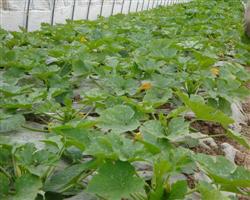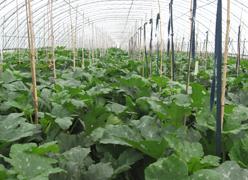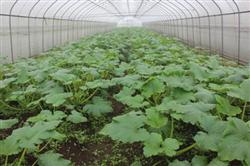High-yielding cultivation techniques of summer squash in greenhouse in autumn and winter

Firstly, the zucchini hybrids with early maturity, high yield, rapid growth and trailing characteristics should be selected for the selection of excellent varieties. Second, cultivate strong grafted seedlings 1. Sowing time. The sowing time of zucchini in autumn and winter in greenhouse is generally from the first ten days of September to the middle of September, the seed amount per mu is 500g; the seed amount of rootstock sunspot pumpkin is 800g-1000 g, sowing at the same time with zucchini. 2. Grafting method: insertion method and leaning method can be used. Insertion method: first, remove the true leaves of the black-seeded pumpkin with a bamboo stick, then insert a hole between the two cotyledons, then remove the roots of the scion zucchini seedlings, cut into a vertebral tip 0.5-0.8 cm from the Hypocotyl, and pour water to cover the shed. 3. Grafting time. Using sand bed to raise seedlings, zucchini and black seed pumpkin were raised on two sand beds respectively, and began to be grafted when the true leaves of the seedlings were exposed. It usually takes about 5 days from sowing to grafting. 4. Seedling stage management. After the grafted seedlings were planted in the nutrition bowl, the grafted seedlings should be fastened to the shed in time to keep the temperature at 20-25 ℃. After grafting for 2-4 days, the seedlings were properly shaded in the strong light at noon, and the seedlings were properly released 5 days later. The humidity in the shed of grafted seedlings must be kept above 75%. At the same time, the regenerated leaves of black-seeded pumpkin should be knocked off in time. Third, planting 1. Apply basic fertilizer for soil preparation. Before transplanting the greenhouse, we should apply sufficient basic fertilizer, 1500-150kg per mu of rotten farm manure, 100150kg of fermented rapeseed cake, 50kg of ternary compound fertilizer, 10kg of urea, evenly spread and spread evenly, the border is 0.8m wide, 0.1m high and 0.5m wide, then cover with plastic film to be planted. 2. Drilling and planting. Punch holes according to 0.45 m plant spacing, 2 rows per ridge, pour water thoroughly, and transplant ridges after being soaked in water. The transplanting time is about 2500 trees per mu in the first and middle of October. Fourth, greenhouse growth period management 1. Temperature management. After planting, zucchini grows rapidly, after entering November, it should be properly watered, then buckle the shed and weed in time to get rid of pumpkin regenerated leaves. After winter, it should be covered with heat preservation in time to ensure the normal growth of zucchini. 2. Fertilizer and water management. Zucchini should be watered as little as possible before blooming. After sitting on the melon, should properly irrigate small water, after entering the winter basically does not need to water, only unifies the medicine to carry on the foliar topdressing. 3. Pruning of hanging vines. The zucchini of the first generation of Zaoqing has the characteristic of dragging vine. Hanging vine cultivation can increase the planting density, prolong the growth period, bear melon early and increase the yield. Hanging vine is an important measure for high yield and high efficiency of zucchini. In the first ten days of November, the vine should be suspended in time, and the excess side branches should be knocked off at the same time to reduce nutrient consumption. 4. Increase the rate of melon setting. In order to improve the melon setting rate of western gourd, artificial pollination should be carried out in time, and then 10-15 mg / L 2jue 4LV D solution should be applied on the melon stalk, or Shennong No. 2 water solution should be used to soak flowers and fruits so as to prevent flowers and fruits from falling and promote the consistency of fruit expansion. 5. Pest control. Zucchini pests are mainly aphids, which are controlled by 40% omethoate. The main diseases are powdery mildew, gray mold, etc., which can be controlled by 70% chlorothalonil 700 times solution.
- Prev

How to prevent melons from melting of zucchini in greenhouse
Flushing fertilization is a kind of fertilizer which is suitable to be applied with water, and its nutrients have good water solubility. Some of the products are prepared according to the fertilizer characteristics of zucchini, which are special fertilizer for zucchini. These fertilizers generally contain not only nitrogen, phosphorus and potassium, but also boron, zinc, iron, calcium, magnesium and other crops.
- Next

Spring zucchini should be protected from more nitrogen and less potassium.
There is more nitrogen and less potassium. The demand of zucchini for nitrogen, phosphorus and potassium is the most, followed by nitrogen and phosphorus. The temperature is higher in spring, if there is too much nitrogen fertilizer, it is easy to cause zucchini to grow too much. Therefore, topdressing in spring must pay attention to less application of nitrogen fertilizer, mainly high potassium compound fertilizer. Protect against high temperature and drought. Zucchini can not stand high temperature, high temperature.
Related
- Where is it suitable to grow horseradish in China? it is expected to see the middle altitude horseradish in Alishan.
- How to prevent tomato virus disease reasonably? (Control methods included)
- Many people like to plant towel gourd on the balcony. What are the main points of this method and management?
- What crops can chili peppers be mixed with?
- Fertilization techniques and matters needing attention in Tomato
- What are the grafting techniques for peach seedlings in spring?
- Harm and control methods of root swelling disease of Chinese cabbage
- What are the pests of sweet potatoes? How to prevent and cure it?
- Symptoms, causes and Control methods of navel Rot in Tomato
- The cause of "Cucumber rotten bibcock" in Farmers' planting Cucumber and its Control Plan

